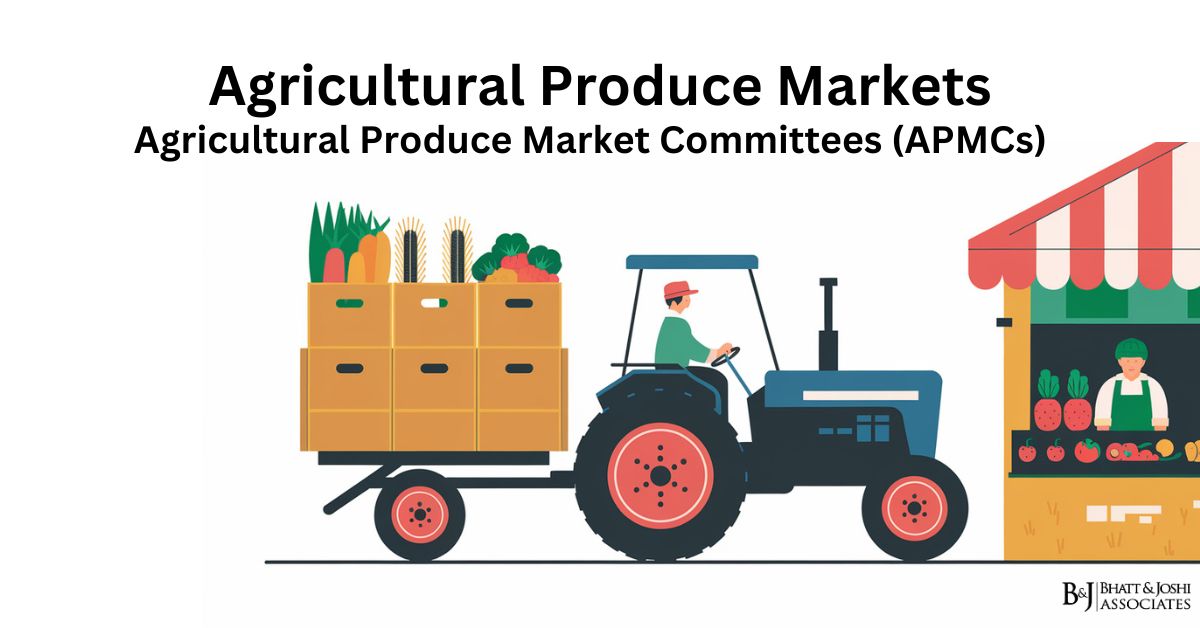Introduction
Agricultural Produce Market Committees (APMCs) form the core of India’s regulated agricultural market structure, designed to protect farmers from exploitation by ensuring fair pricing, transparency, and regulated trade. Established under various state laws, APMCs were intended to regulate the marketing of agricultural products and prevent monopolistic behavior. However, the functioning of APMCs has seen multiple reforms, legal challenges, and debates, leading to calls for more liberalized market conditions. This article dives deeper into the legislative framework and judicial interventions that govern the APMCs, offering a comprehensive view of how these committees have evolved over the years.
Historical Background and Formation of Agricultural Produce Market Committees (APMCs)
The origins of regulated agricultural markets in India date back to the early 20th century, but the structured establishment of APMCs began post-independence. The primary objective was to create an organized system where farmers could sell their produce in a regulated environment, free from exploitative practices of intermediaries.
The enactment of state-level Agricultural Produce Market Acts (often referred to as APMC Acts) was based on the recommendations of the Royal Commission on Agriculture (1928) and later bolstered by the First Five-Year Plan (1951). The primary mandate of these Acts was to create an efficient marketplace for agricultural commodities.
Key Legislation Governing Agricultural Produce Market Committees (APMCs)
State Agricultural Produce Market Acts
Most Indian states have enacted their own versions of the APMC Act, which provide the legal framework for the establishment and regulation of agricultural markets. For instance:
- The Maharashtra Agricultural Produce Marketing (Development and Regulation) Act, 1963 governs agricultural marketing in Maharashtra. It mandates the establishment of regulated markets and provides the APMC with powers to oversee the purchase and sale of agricultural produce, license traders, and ensure that auctions are conducted fairly.
- The Karnataka Agricultural Produce Marketing (Regulation and Development) Act, 1966, similarly, establishes regulated markets across the state to protect farmers from unfair practices and promote the development of market infrastructure.
The Essential Commodities Act, 1955
Though not specific to APMCs, the Essential Commodities Act plays a significant role in regulating agricultural markets by controlling the production, supply, and distribution of essential commodities. It allows the government to intervene in the pricing and stock limits of essential agricultural produce, often working in tandem with APMCs to regulate trade during periods of scarcity.
Model APMC Act, 2003
To standardize agricultural marketing across states, the central government introduced the Model APMC Act in 2003. This Act encouraged states to reform their agricultural marketing laws to promote direct marketing, contract farming, and the establishment of private markets. The Model Act attempted to liberalize the agricultural markets, reduce the monopoly of APMCs, and allow more players in the market.
However, despite the Model Act’s progressive intentions, its implementation by state governments has been uneven, with many states reluctant to adopt the suggested reforms.
The Farmers’ Produce Trade and Commerce (Promotion and Facilitation) Act, 2020
The Farmers’ Produce Trade and Commerce (Promotion and Facilitation) Act, 2020, aimed to further liberalize agricultural markets by allowing farmers to sell their produce outside the APMC-regulated mandis without incurring market fees. The Act created provisions for establishing private markets and promoted inter-state and intra-state trade of agricultural produce without the need for APMC intervention.
However, the law faced significant opposition from farmer unions, who argued that bypassing the APMCs would weaken the mandi system, leaving small farmers vulnerable to exploitation by corporate buyers. The massive protests that followed led to the eventual repeal of the 2020 Farm Laws in 2021.
Case Laws Impacting Regulation
State of Gujarat v. Shree Ambica Mills Ltd. (1974)
This case laid the foundation for APMCs by affirming the power of states to regulate agricultural markets. The Supreme Court held that state laws regulating agricultural markets fall under the State List of the Constitution and are within the legislative competence of state legislatures. The judgment confirmed that APMCs, formed under state laws, are constitutional and can regulate trade in agricultural commodities.
ITC Ltd. v. Agricultural Produce Market Committee and Others (2002)
One of the landmark cases related to APMCs was ITC Ltd. v. Agricultural Produce Market Committee and Others. In this case, ITC Ltd. challenged the imposition of market fees by APMCs on tobacco that was directly purchased from farmers outside the regulated markets. ITC argued that since the tobacco was not sold within the mandi system, the APMC could not levy fees.
The Supreme Court ruled that APMCs had the authority to levy market fees even for purchases made outside the physical boundaries of mandis if the produce was ultimately marketed within the state under the APMC Act. This judgment highlighted the far-reaching powers of APMCs under state laws and emphasized their jurisdiction over agricultural trade even beyond physical market premises.
Maharashtra Rajya Fadtolanna Vyavasayik Sangh v. State of Maharashtra (2010)
This case examined the monopoly control of APMCs and the extent to which state governments could intervene to establish alternative markets. The petitioners argued that the APMCs’ control over agricultural markets led to inefficiencies and exploitation of farmers. While the court upheld the role of APMCs, it also recognized the need for reform and the potential for introducing competition through private markets and alternative marketing channels.
Union of India v. Raj Chandra Srivastava (1976)
This case involved a dispute regarding the imposition of market fees by APMCs. The Supreme Court ruled that the imposition of market fees was valid as long as the services provided by the APMCs benefitted the trading community, including farmers and traders. The court upheld the legality of market fees, stating that such fees were essential for maintaining market infrastructure and ensuring the proper functioning of mandis.
Regulation, Reforms, and Challenges of Agricultural Produce Market Committees (APMCs)
The role of APMCs has been continuously evolving, but their regulatory framework still faces several challenges that have prompted calls for reforms. Below are some of the key challenges:
Monopoly of Agricultural Produce Market Committees (APMCs)
One of the biggest criticisms of the APMC system is the monopolistic control that these committees exercise over agricultural markets. In several states, farmers are legally mandated to sell their produce through APMC-regulated mandis, which limits their options for direct marketing or selling to private players. This monopoly often results in a lack of competition, leading to lower prices for farmers.
Lack of Transparency
Despite the mandate to ensure transparent and fair auctions, APMCs have been accused of fostering corrupt practices. The presence of commission agents (arhatiyas) who act as intermediaries between farmers and buyers often leads to non-transparent pricing mechanisms, where farmers receive a fraction of the market price due to commissions and other deductions.
Excessive Fees and Levies
APMCs collect various market fees from traders, buyers, and even farmers, which increase the transaction cost of agricultural trade. In many cases, these fees are passed onto the farmers in the form of lower prices. Critics argue that these levies discourage the free movement of agricultural produce, particularly in states where market fees are exorbitant.
Slow Adoption of Reforms
Although the Model APMC Act of 2003 and the Farm Laws of 2020 were introduced to liberalize agricultural markets, their adoption has been slow and uneven. Many state governments, which rely heavily on the revenue generated from APMC markets, have been reluctant to adopt reforms that would diminish the role of APMCs and promote private market competition.
Recent Developments in APMC Regulation
In recent years, there has been a growing movement to modernize agricultural markets and reduce the monopolistic control of APMCs.
National Agriculture Market (eNAM)
The National Agriculture Market (eNAM), launched in 2016, is an online trading platform that integrates APMCs across India to create a unified national market for agricultural produce. The platform allows farmers to sell their produce across state borders without being restricted to local mandis. eNAM aims to promote transparent and competitive price discovery by facilitating online bidding for agricultural produce. As of 2021, over 1,000 mandis across India have been integrated into the eNAM platform.
Promotion of Direct Marketing and Contract Farming
Many states have amended their APMC Acts to allow for direct marketing and contract farming, which enable farmers to bypass the mandi system and sell directly to buyers. Contract farming, in particular, has gained traction as it provides farmers with price assurance before sowing, thereby reducing market risks.
Conclusion
Agricultural Produce Market Committees have played a vital role in regulating India’s agricultural markets, providing farmers with a structured environment for selling their produce. However, the functioning of APMCs has been marred by inefficiencies, monopolistic practices, and corruption, leading to calls for reforms.
Legislative reforms, such as the Model APMC Act of 2003, the 2020 Farm Laws, and the eNAM initiative, have aimed at liberalizing agricultural markets and reducing the dominance of APMCs. However, the slow adoption of these reforms and the political resistance from farmer groups have left the agricultural marketing system at a crossroads. As India continues to explore ways to modernize its agricultural markets, the role of APMCs will likely evolve to accommodate more liberalized and transparent marketing practices, benefiting both farmers and buyers alike.














